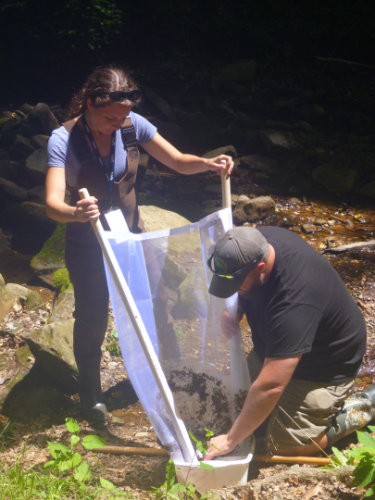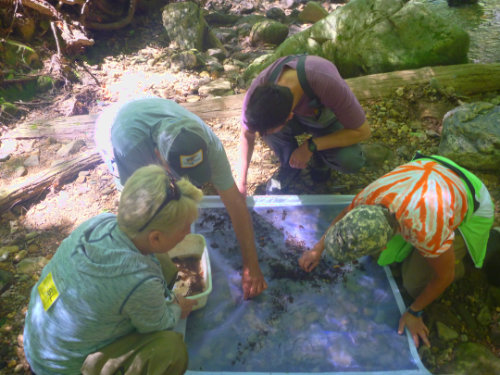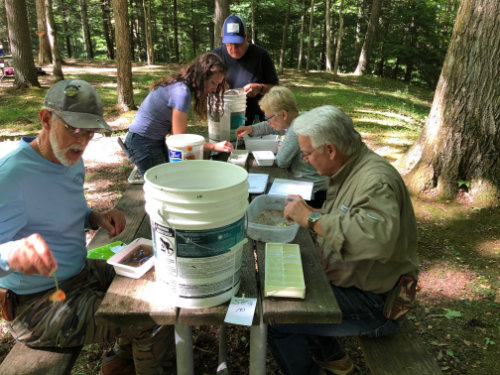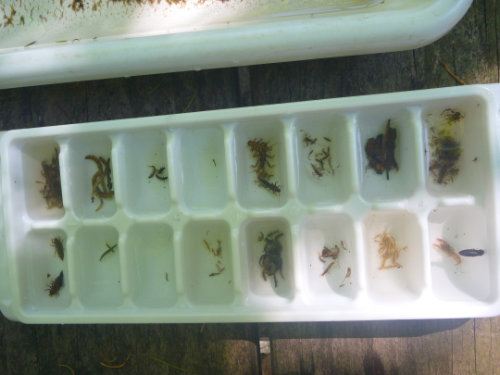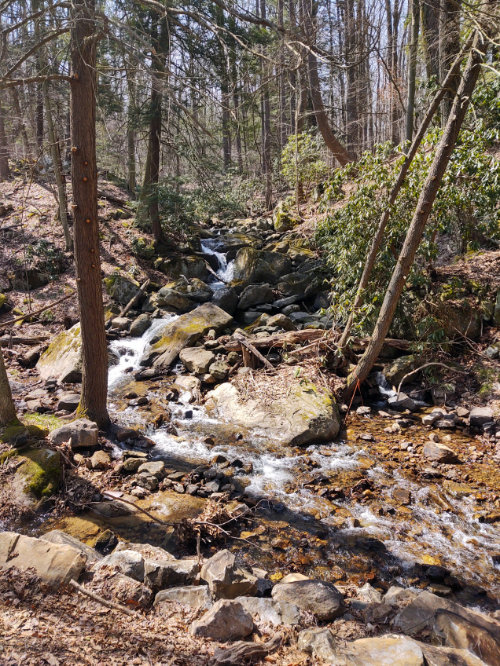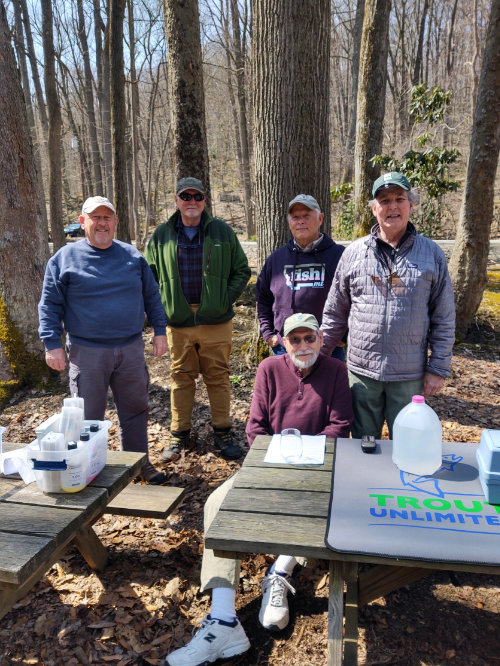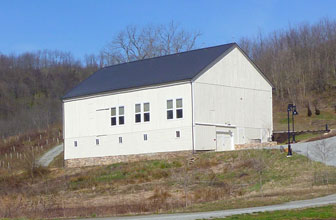Category: Rock Run
Year End Rock Run Water Tests
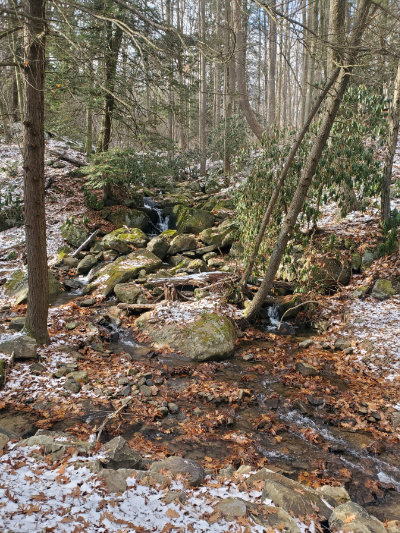
Icy temperatures and the first dusting of snow greeted the testers as the final water sampling at the mouth of Rock Run for 2021 was done on Saturday, November 27.
Air Temperature: 25° F
Water Temperature: 34.5°F
Linn Run Discharge: 7.95 ft³/sec
Linn Run Gauge: 1.76 ft.
pH: 7.7
Alkalinity: 7.8
The final averages for the year are 7.43 pH and 7.03 alkalinity. These are the best averages we’ve recorded since we began taking monthly readings in 2017.
2017-2018: pH-6.47, Alkalinity-5.9
2018-2019: pH-6.5, Alkalinity-6.1
2019: pH-6.5, Alkalinity-6.2
2020: pH-6.88, Alkalinity-5.92
2021: pH-7.43, Alkalinity-7.03
Plans are to add limestone to the headwaters in 2022.
Click Here Rock Run pH Chart 2021 for the complete 2021 chart.
Rock Run Water Tests November 2021

Here’s the results of water tests for November 2021 (taken October 30).
Air Temperature: 50° F
Water Temperature: 51º F
Linn Run Discharge: 16.0 ft³/sec
pH: 7.6
Alkalinity: 8.4
Good sign that alkalinity held up pretty well with recent rains and increased flow.
A kick-net survey was also done on the lower section of Rock Run. The survey scored a 28.4 which is in the fair range for a water quality score.
Click here pH Chart 2021 for a complete run down of 2021 water quality tests for Rock Run.
Rock Run Water Tests – October 2021

Mornings have turned chilly in the Laurel Highlands. Here’s the Rock Run Water test results for October 2, 2021.
Air Temperature: 54° F
Water Temperature: 53.5° F
Linn Run Discharge: 3.99
Linn Run Gauge: 1.55
pH: 7.55
Alkalinity: 9.6
Rock Run Water Tests 8.28.21
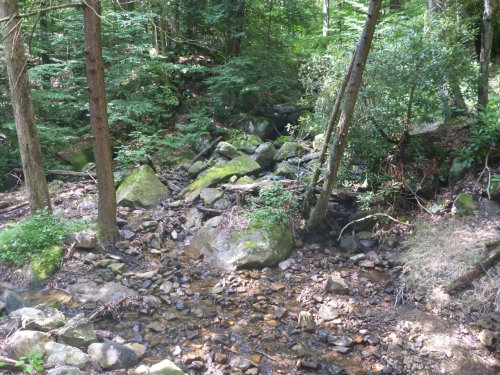
Good numbers from Rock Run this month. Even though recent storms raised the flow a little, alkalinity increased.
Air Temperature: 75° F
Water Temperature: 67.5° F
pH: 7.5
Alkalinity: 12.3
Linn Run Gauge: 1.44
Flow: Low and clear.
Rock Run August Water Quality Tests

Midsummer low flows greeted the testers. Rain, please!
Air Temperature: 61° F
Water Temperature: 62° F
Linn Run Discharge: 2.4
Linn Run Gauge Height: 1.32
pH: 7.5
Alkalinity: 11.7
Rock Run Water Tests July 2021
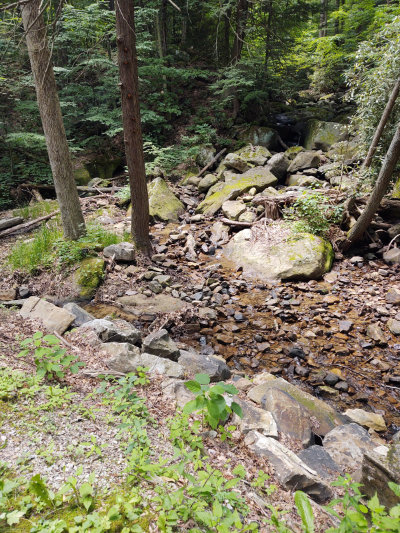
Lowest flow of the year yields the highest alkalinity reading this so far this year.
Air Temperature: 81° F
Water Temperature: 66°F
pH: 7.5
Alkalinity: 10
Linn Run Gauge Height: 1.36
Linn Run Discharge: 2.87
Linn Run Conservation Plan Work Continues with Macro Study
On Wednesday, June 16, FTTU volunteers gathered at the Grove Run Picnic area in Linn Run State Park to do a comprehensive aquatic macroinvertebrate collection and study of Linn Run and its tributaries. Andrea Kautz, Research Entomologist at the Powdermill Nature Reserve, and Josh Penatzer, Project Manager with the Loyalhanna Watershed Association, were the professionals who supervised the study. Previously, Andrea conducted a macro identification training session for volunteers via zoom, and both Andrea and Josh demonstrated the use of kick nets, explained the collection protocol, and oversaw the identification, sorting and scoring process on site. FTTU members with previous experience in macro collection led teams that carried out the kick net collection at 11 different sites within the watershed. Each site had at least 200 organisms captured. The samples were collected in buckets and brought back to the Grove Run Picnic Area where they were counted and sorted to the Genus level and then returned to the stream. All this work was carried out between 1:00 pm and 7:00 pm thanks to the great response we had from volunteers and Andrea and Josh’s guidance.
The numbers and types of macroinvertebrates inhabiting a stream are great indicators of stream health particularly the “high quality” Genus’s of mayflies, stoneflies and caddis flies.
The final report for the Linn Run Coldwater Conservation Plan will be produced in about one year. The study is to determine the overall health of Linn Run and the fishery. Next step, based on the information collected, is to determine if there are potential remediation projects we can undertake that might improve stream health and trout habitat.
Rock Run Data For June 2021

Monthly water testing results for Rock Run:
Air Temperature: 48° F
Water Temperature: 52.5° F
Linn Run Discharge: 28.1 ft³/sec
Linn Run Gauge: 2.08 ft.
pH: 7.5
Alkalinity: 7.4
Rock Run Water Tests For May

Here’s the results of water sampling at the mouth of Rock Run done on May 1, 2021.
Air Temperature: 39° F
Water Temperature: 44.5°
Linn Run Discharge: 33.4 ft³/sec
Linn Run Gauge Height: 2.17 ft.
pH: 7.4
Alkalinity: 4.3
Rock Run Water Testing April 2021
Water sampling was done at the mouth of Rock Run on April 5.
Air Temperature: 55° F
Water Temperature: 46° F
Linn Run Gauge Height: 1.95
pH: 7.3
Alkalinity: 3.9
This month, Denny Hess conducted a training session on how to use the pH meter and do the alkalinity titration test.
Click here Rock Run pH Chart 2021 for the rundown on monthly test results for this year.



